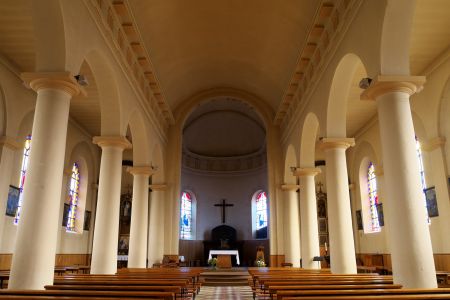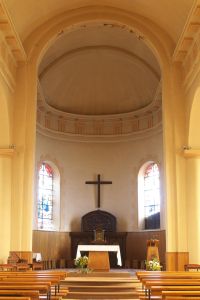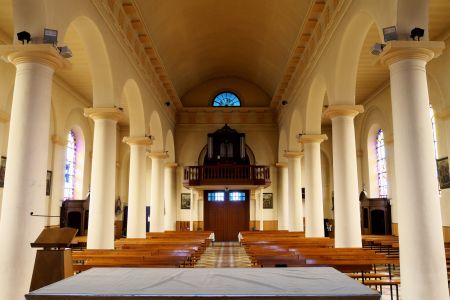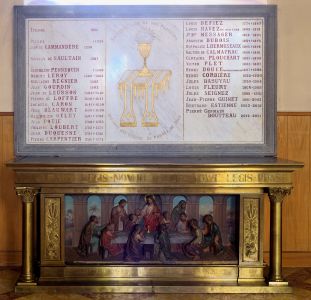Church | 1820-1823 | Neoromanesque | Catholic Church



Map
Opening hours
01 January - 31 December
Mon 9.00 - 17.00
Tue 9.00 - 17.00
Wed 9.00 - 17.00
Thu 9.00 - 17.00
Fri 9.00 - 17.00
Sat 9.00 - 17.00
Sun 9.00 - 12.30
Description
Its relatively recent history contrasts with that of the commune, whose origins date back to Antiquity. Gallo-Roman ceramic workshops have been discovered during archaeological excavations.
The first documented church dates back to before the 12th century. At the time, it belonged to the Marchiennes abbey, which was itself attached to the diocese of Arras. The latter donated the church of Coutiches to Bourbourg Abbey in the 12th century.
Nothing has survived of this building, but an illustration dating from 1607, preserved in the Croÿ albums, offers a glimpse of it. At the heart of the village stands the long spire of a two-aisled church. The Chapelle des Fièvres can also be seen in the distance.
Records show that the church was already dedicated to Notre-Dame when, in the 17th century, the parish priest Blauwart added the name ‘De Foy’, in homage to the recent and important Belgian pilgrimage bearing that name.
During the French Revolution, the church was sold as national property to a Douais resident, who had it completely demolished in order to salvage the materials.
It was not until 1823 that a new building was constructed by the local architect Bonlet, based in Douai. The church was built in brick in a total neo-Romanesque style. A new spire was added in 1855 by the architect Louis Colbrant.
Photos
Remarkable elements
Stations of the cross
It was created by the famous Belgian painter and sculptor Pol Bury (1922-2005).
The Last Supper
A bas-relieved oak panel probably dating from the 17th century.
This panel was discovered following the retreat of German troops in 1918.
The scene depicts Christ surrounded by his 12 apostles at his last meal before his arrest.
Virgin and Child, known as Notre-Dame-de-Foy
Polychrome wooden statue dating from the 18th century.
Notre-Dame de Foy is a miraculous Virgin whose devotion is relatively recent. In 1609, a woodcutter from Wanlin, a Belgian commune in the Namur region, felled a tree in which he discovered a terracotta statue of the Virgin and Child. The tree was on the route taken by Saint Hubert's pilgrims, and one of them had probably placed the statue there.
Initially placed in another tree, it was later sheltered in an oratory in the Château de Vêves. It soon attracted many pilgrims, and the first miracle was recorded in 1616: a man was cured of a hernia.
18th-century wooden statues
These statues, placed above carved and gilded wooden altarpieces, are protected as historic monuments.
One depicts Saint Catherine, the other Saint Roch, not with his traditional dog, but accompanied by an angel.
Notre-Dame des Fièvres stained glass window
Donated by local families, these stained glass windows each depict a saint.
One of them represents Our Lady of Fevers, to whom a local cult is dedicated. Every year, a novena is celebrated in her honour.
This cult developed near an ancient spring, venerated since Antiquity and whose virtues were Christianised in the Middle Ages. A large chapel was built there before being destroyed during the French Revolution. A new, more modest chapel was rebuilt in the 19th century.
This spring, reputed to cure fevers, hence its name, was also invoked in desperate cases.


















